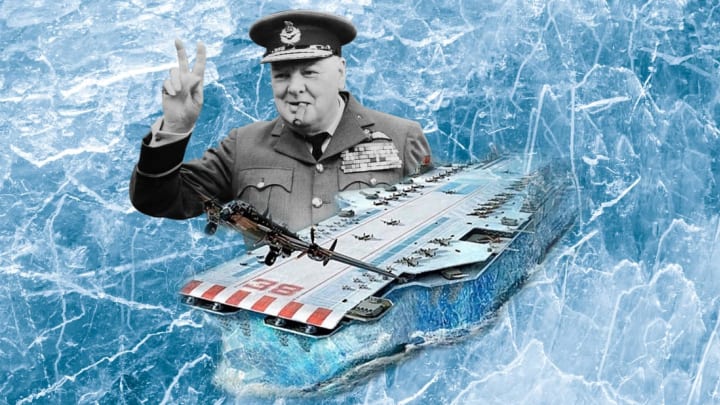Winston Churchill was enjoying a steamy bath when he discovered the secret to winning World War II floating in his tub. It was 1942, and Lord Louis Mountbatten, the Chief of Combined Operations and Britain’s head honcho for unconventional warfare, had stormed into the Prime Minister’s bathroom with unexpected news. (It’s not as strange as it sounds. Churchill regularly conducted meetings from his tub.)
“I have a block of new material that I want to put in your bath,” Mountbatten explained. He dropped a hunk of ice between Churchill’s legs. The two watched in awe as the ice refused to melt.
At the time, Churchill was in a pickle. The Soviets were fighting Germany on the eastern front, but the UK, which had yet to successfully invade Europe from the west, sat in limbo. Knowing that Britain was utterly dependent on imports, German U-boats routinely targeted merchant ships bound for the UK, sending the food and goods intended for citizens and soldiers to the bottom of the ocean.
Those ships needed protection badly, but aircraft based on shore didn’t have the range to offer cover, leaving vessels to navigate a perilous 300-mile stretch of undefended ocean on their own. Experts called this vulnerable territory the "mid-Atlantic gap." Others simply called it "The Black Pit."
Mindful of the gap, Churchill believed a series of floating airfields in the Atlantic could close the distance between his air force and enemy submarines. With aircraft carriers in short supply, he wanted to establish a string of unsinkable floating islands that could serve as hangars and refueling depots. The catch? These buoyant land strips had to be constructed out of a material other than steel; the Allies needed every ounce of the metal for weapons, tanks, and battleships.
Churchill was convinced the solution was bobbing in his bathwater.
For a time, the British seriously considered using ice as a construction material for their floating airfields. Ice, after all, doesn’t sink. Repairs would be easy: just add water. Churchill naively believed it was as simple as chiseling off a slice of the Arctic ice shelf and tugging it back to Cornwall.
There were obstacles, of course. Ice melts, and nobody wanted to send a fleet of floating islands into the Atlantic just to watch them disappear. Ice is also brittle, and Churchill's men knew that if an airfield were too thin, a bomb could split it in two. Icebergs have also been known to violently flip over, and the same went for Churchill’s airfields, which were one well-placed strike away from dumping hundreds of flyboys into the drink.
Geoffrey Pyke, the scientist who cooked up the idea of ice-based airfields in 1942, directed the researchers of Britain's Combined Operations to find a way to make strong, unmeltable ice. He focused his attention on a little-known report by Herman Mark, a Vienna-based professor of chemistry who had fled the Nazis, which explained how a simple mixture of wood pulp, sawdust, or cotton could reinforce ice in the same way that steel wires bolster concrete.
The report was no joke. Pyke's men found that even a small addition of wood pulp worked miracles: It insulated the ice, prevented most melting, and resulted in blocks of building material that were as resilient as concrete. Pyke's men named it “Pykrete,” and when the Prime Minister saw it floating in his bathtub, he was sold.
“It would be of ship-like construction, displacing a million tons, self-propelled at slow speed,” Churchill wrote in his 1951 book Closing the Ring, “with its own anti-aircraft defense, with workshops and repair facilities, and with a surprisingly small refrigerating plant for preserving its own existence.” It would be called Project Habakkuk, named after the Hebrew prophet who wrote, “Look at the nations, and see! Be astonished! Be astounded! For a work is being done in your days that you would not believe if you were told.”
The code name was apropos. The proposed aircraft carrier was destined to be 2000 feet long and 100 feet thick. (Ten times thicker than the average sheet of Arctic ice, by the way.) It would have a cruising range of 7000 miles, requiring 26 electric motors and a 15-story rudder. It would displace 26 times more water than the largest ship in the world.
The carrier's awesomeness didn't end at its massive size. Max Perutz, a scientist who worked on the project, wrote in The New Yorker that the “bergships were to carry enormous tanks full of supercooled water—liquid water cooled below its normal freezing point—which could be sprayed at the enemy to solidify on contact.”
In other words, freeze rays.
In 1943, the British presented the idea to American commanders during a secret meeting. Accounts vary, but as Perutz told it, Lieutenant Commander Douglas Grant brought two blocks of ice—one regular, one Pykrete—whipped out a pistol, and fired two shots. The first bullet shattered the ice. The second bullet hit the Pykrete, ricocheted, and tore into a high-ranking officer’s shoulder. The Pykrete, however, was unharmed.
The Americans signed on.
That summer, the military built a prototype in Alberta, Canada. Local mills supplied the pulped wood, while laborers at a 200-acre refrigeration plant froze water into monolithic cubes. Within months, a 60-foot-long ice boat rested on a nearby lake. It weighed as much as five blue whales.
But the project went no further. By late 1943, Allied factories had built new fleets of aircraft carriers. With the flying range of new military airplanes (aptly named very-long-range aircraft) improving and the pace of manufacturing gaining steam, the mid-Atlantic gap had already closed. Improvements to radar and an increase in destroyer escorts spelled trouble for Germany's U-Bootwaffe, which would lose a quarter of its submarines that year. Officials poring over production numbers concluded that constructing a fleet of berg-boats was an unnecessary money trap. They scuttled the mission, and the Pykrete barge was abandoned to slowly melt.
